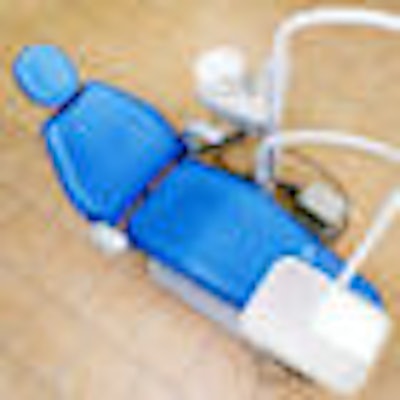
Editor's note: This article first appeared on the website Dental Intelligence on January 17, 2011. Reprinted with permission of William T. Brown, DDS.
The significance of the reclining contour dental chair is often overlooked, especially with dentists who didn't make the transition from low-speed handpieces to the air rotor. Instead of the old style handpiece with the "rope" that made the burrs rotate, the high-speed air rotor required copious water coolant. The volume of water in the patient's mouth gave rise to the "drill-rinse-spit" cycle.
With low-speed dentistry, the patient was upright, the dentist stood next to the patient, and there was a "cuspidor" where the dental assistant is seated now. But the water coolant needed with the high-speed air rotor required high-volume oral evacuation by a seated dental assistant, a seated dentist, and the patient in a supine position between them. This was a major change in the dental operatory and the delivery system.
That's where John Naughton comes into the picture. Naughton was raised on a farm in Iowa, was dyslexic, and dropped out of school at age 15.He worked in a local pharmacy, was in the military, and became a Fuller Brush salesman. Naughton's brother made contour chairs in his garage in Des Moines. In 1958, Naughton started selling the chairs and hauled the model around in a used funeral hearse. One of the places he showed his chair was the Iowa Dental Association annual meeting.
Naughton knew this would be a good venue for his contour chair because most dentists had bad backs from standing on one foot for 40-40 (40 hours a week for 40 years). He reasoned that a contour chair would be welcomed by the dentist when he went home at night with an aching back.
An innovative dentist from Britt, IA, was an early adopter of the new technology of the high-speed drill. The doctor asked Naughton if he could make one of his chairs for a dental office. The answer, of course, was "yes."
They developed the chair for dental use and dubbed it the Den-Tal-Eze. Naughton then went to the owner of Iowa Dental Supply, Noche Cacciatore, for advice. Naughton told Notche that he could sell the contour dental chair for $300 and make a profit. Cacciatore said, no, that won't work. He told Naughton, "Make the chair for $300, give the dental supply dealer $300, and keep $300 for yourself -- sell it for $900."
That advice proved to be the magic formula. Naughton's company never borrowed a dime and went on to have a highly successful dental manufacturing concern. In addition, Den-Tal-Eze manufacturing had a well-designed educational system to assist dental team transition. The original chair was displayed in the Smithsonian museum and now resides at the Dr. Samuel D. Harris National Museum of Dentistry in Baltimore.
John Naughton was a patient in my practice, and we lived in the same neighborhood in Des Moines.
(Note: Dr. John Anderson of Glenview, IL, and Dr. Meigs Jones of Kansas City, MO, also were involved in the contour chair development.)
William T. Brown, DDS, practices in Des Moines, IA. He started his blog, Dental Intelligence, in 2010 "to share information and experiences that have fundamentally changed the way dentistry is practiced."
Copyright © 2011 William T. Brown, DDS



















